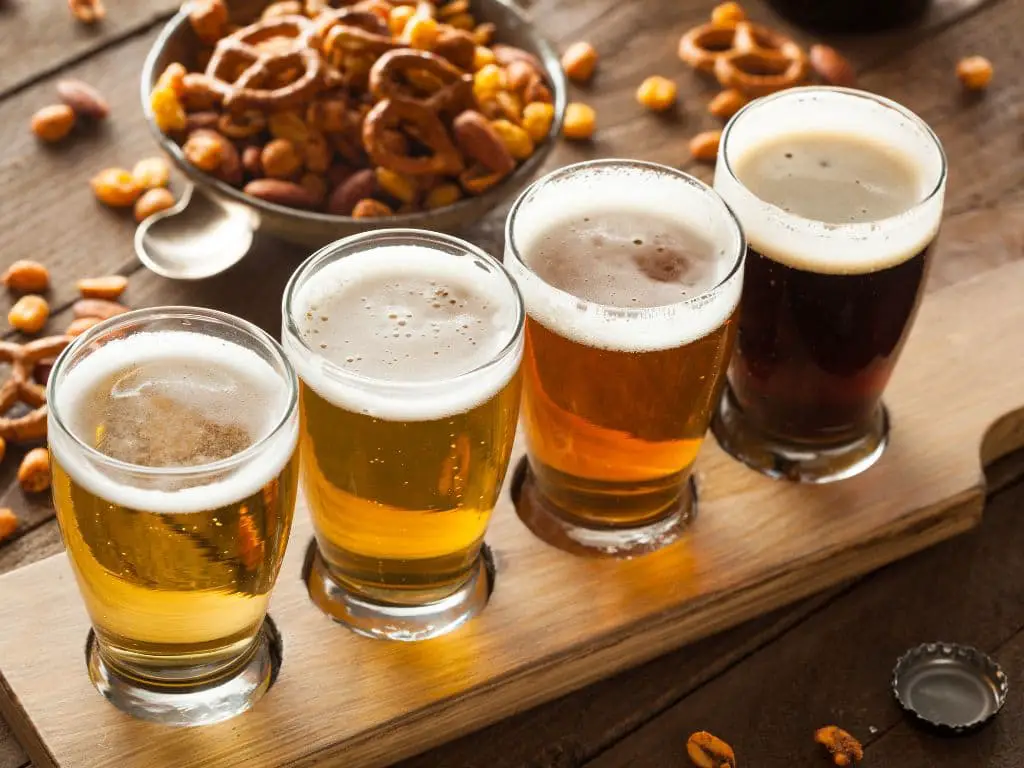Is a Cider a Beer?
No, a cider is not a beer. The primary distinction between the two is their main ingredients; cider is made from fermented apple juice, while beer is produced from malted barley and hops. Additionally, cider making does not involve the brewing process used in beer production, instead, apple juice is directly fermented into cider.

What is The Difference Between Cider and Beer?
The main difference between cider and beer lies in their primary ingredient and manufacturing process – cider is made from fermented apple juice, whereas beer is made from brewed barley.
Cider and beer are distinct alcoholic beverages that primarily differ in their base ingredients and production methods.
Cider is an alcoholic beverage produced by fermenting apple juice. This is achieved by pressing apples to extract the juice, which is then fermented with yeast to create a liquid known as “must.” The fermentation process converts the naturally occurring sugars in the apple juice into alcohol, thus creating cider. The taste, color, and clarity of the finished product can vary greatly depending on the variety of apples used, the length and method of fermentation, and any additional flavoring ingredients added. Cider can be classified by different factors such as the type of apples and pears used and the degree of dryness. It may also be combined with other fruits and flavors to showcase its versatility. Additionally, cider is often marketed as a gluten-free alternative to beer.
On the other hand, beer is produced from starch-based malted cereals, usually barley, through a brewing process. The production process involves steeping the barley grains to convert the starches into sugars, creating a liquid known as “wort.” The wort is then boiled with hops, which contributes bitterness and aroma to balance the sweetness of the malt. This mixture is then fermented with yeast, turning the sugars into alcohol and producing beer. Beer is categorized mainly into two types – lagers and ales, each with their distinctive flavor profile and fermentation process. The beer’s color is primarily determined by the roasting level of the malt used. Beers may also differ in their alcohol content, and non-alcoholic versions are available as well.
Ingredients Used in Cider and Beer
Cider, at its simplest, is made from fermenting the juice of apples. The basic ingredients used in cider are apples, yeast, and sometimes added sugars. The variety and quality of apples used in cider-making will significantly influence the cider’s flavor and color. The cider making process involves crushing and pressing apples to obtain juice, which is then fermented with the help of yeast. The yeast consumes the natural sugar present in apple juice producing alcohol and carbon dioxide. The resultant product is cider which can vary from completely clear to very cloudy, and from pale yellow to rich hues of orange and brown based on the type of apple and the process of fermentation used.
Beer, on the other hand, is a complex concoction traditionally brewed from malted barley, hops, water, and yeast. The malted barley or other cereal grains provide the sugars necessary for fermentation, while the hops contribute to the flavor, aroma and bitterness of the brew. The yeast consumes the sugars from malted barley, turning them into alcohol and carbon dioxide. The brewing process of beer involves steeping the grains in hot water to release sugars, boiling the obtained liquid with hops, and then fermenting it. The colour of beer is mostly determined by the roasting/heating of the malt used in the brewing process. Beer colours vary from light amber from using pale malt to rich brown from using a mix of dark malt.
It’s worth mentioning that there exist many varieties within each of these beverages, resulting from the use of different types of grains, apples, yeasts and additional ingredients or flavors, which will further diversify the range of flavors, colors, aromas, and textures achievable.
Fermentation Process of Cider and Beer
The fermentation process of cider and beer refers to the biochemical transformation that occurs when yeast converts the sugar present in apple juice or malted barley, respectively, into alcohol and carbon dioxide.
For cider, fresh, ripe apples are first washed and crushed to extract the juice. This apple juice is then transferred into fermentation vessels, often large stainless steel tanks or oak barrels. To this juice, a selected strain of yeast is added, which commences the fermentation process. The yeast consumes the naturally-occurring sugars in the apple juice to produce mainly alcohol and carbon dioxide, a process which typically takes between one to two weeks but can vary depending on multiple factors such as temperature, yeast strain, nutrient availability and the desired character of the cider. Once the yeast has consumed all the sugars, the cider then undergoes a clarification process where residue yeast and other solids are filtered out. Following this, the cider may be aged in its fermentation vessel for a varying period of time to develop complexity and character before it finally gets bottled and sold.
Beer fermentation, on the other hand, starts with malted barley, which is soaked in hot water to convert the barley’s starches into fermentable sugars. This sugar-rich liquid, now called the ‘wort’, is then boiled with hops for seasoning. The hop-infused liquid is then cooled and transferred to a fermentation vessel, where yeast is added. This yeast consumes the fermentable sugars present in the wort and converts it to alcohol, carbon dioxide and various flavor compounds through a process termed fermentation. Fermentation in beer typically takes one to two weeks after which the beer, like cider, is clarified by removing the residual yeast and solids. The beer can then be conditioned (or lagered), a secondary fermentation period that allows for the development of a cleaner, crisper flavor, before it is filtered, carbonated, and bottled.
While the fermentation process of cider and beer differ in their raw materials and certain steps, the fundamental science underlying the transformation of sugars into alcohol by yeast remains the same. Both fermentation processes play a key role in shaping the character, taste, aroma, and alcohol content of these beloved beverages.
Taste Comparison Between Cider and Beer
Taste can vary greatly between specific beers and ciders, influenced mainly by the ingredients used and the brewing or fermentation process.
Generally, beer presents a broad spectrum of taste and aroma characteristics, ranging from sweet to bitter, based on the type and quantity of malted barley and hops used in the brewing process. Some beers show a predominantly hoppy bouquet: that is, a bitter, somewhat citrusy, flavor marked by grapefruit, pine, floral, or perfume attributes. Others bear a malt-forward profile, indicated by tastes and aromas of caramel, toffee, bread, toast, or nuts. The taste of beer can also be significantly affected by the choice of yeasts and the fermentation temperature, yielding fruity, spicy, or earthy nuances.
In contrast, cider, typically made from fermenting apple juice, generally carries a fruitier flavor profile. Ciders can range from very dry to exceptionally sweet, depending on the type of apples used and the fermentation process. Naturally, cider offers a pronounced apple flavor, which can vary from tart to sweet to bitter, depending on the apple varietals used. However, many ciders contain additional fruits and spices, bringing diverse flavor undertones such as pear, cherry, raspberry, cinnamon, or vanilla.
The characteristic sweetness of a cider not only separates it from generally bitter beer styles but also makes the drink more quaffable for those who shy away from hoppy bitterness. However, very dry ciders can present a tartness equivalent to some sour beer styles. The use of wild yeasts or maturation in oak barrels can give ciders a complex, robust character akin to certain beer varieties.
While both beers and ciders deliver carbonated, refreshing attributes, cider’s inherent fruit base lends it a smooth, crisp finish that contrasts with beer’s more full and bitter profile. Therefore, their taste comparison comes down to personal preference as some people might find the crisp sweetness of cider more appealing, while others might lean toward the robust, multi-layered flavors of beer.
Alcohol Content in Cider and Beer
The alcohol content in cider and beer can vary widely, based on the fermentation process and the specific brands and types of these beverages. Generally, the alcohol content is indicated by the Alcohol by Volume (ABV) percentage, which measures the total volume of pure ethanol as a percentage of the total beverage volume.
For cider, the alcohol content typically ranges from 4% to 8% ABV, with an average of about 4.5% to 5%. However, some traditional handmade ciders, especially those made in Europe, can contain an alcohol content as high as 12% or more. The alcohol content in cider is dependent on the sugar content of the apples used, the yeast strain, and the fermentation process. Ciders with higher alcohol content usually undergo a longer or more meticulous fermentation process. It’s also worth noting that there are non-alcoholic ciders available, produced through processes that remove or prevent the formation of alcohol.
Beer, on the other hand, tends to have an alcohol content that ranges between 4% and 6% ABV, although this can vary significantly based on the type of beer. Light lagers and pilsners typically have an alcohol content on the lower end of this range, while IPAs (India Pale Ales), stouts, and other specialty or craft beers can have an ABV of 7% or higher. Certain types of beer, such as Belgian ales or barleywines, can boast an ABV as high as 15-20%. Non-alcoholic beers are also available, and typically contain less than 0.5% ABV.
It’s important to keep in mind the ABV when consuming cider or beer, as it can significantly impact the level of intoxication and potential health impacts.
Calorie Count in Cider and Beer
The calorie count in beer and cider can vary significantly depending on the brand, the type, the sugar content, and other factors. That being said, both beverages typically contain a significant number of calories per serving.
In general, a pint of cider (568 milliliters) contains between 200 to 235 calories. This can be attributed to the natural sugars found in apples which are converted to alcohol during the fermentation process. The final calorie content of cider can vary based on factors such as the apple varieties used and the length of fermentation. Furthermore, flavored or sweet ciders may have additional sugars added, increasing the calorie content.
In contrast, beer derives its calories mainly from the alcohol and carbohydrate content. The average calorie count of a pint of beer (568 milliliters) can range from 180 to 250 calories. Light beers, which contain less alcohol, can have as few as 95 to 136 calories per serving. Similar to cider, the final calorie content of beer can vary based on factors such as the type of grains used, the brewing process and any additional flavorings or sugars.
Comparatively, while a pint of cider could be considered to contain more calories, the difference is not substantial. Therefore, from a caloric perspective, there may not be a definitive healthier choice between cider and beer. It’s important, however, to note that the nutritional profile of alcoholic beverages extends beyond their calorie content. Other factors, such as sugar and carbohydrate content, as well as the presence of potential allergens like gluten, should also be taken into account when considering the health implications of these beverages.
Is Cider Healthier Than Beer?
Cider has some advantageous health benefits. One such benefit lies in its composition of polyphenols, natural compounds which improve blood pressure and cholesterol, acting as small aids for heart health. Moreover, polyphenols contribute to better digestion by delivering probiotics and improving gastrointestinal health. Importantly, cider is gluten-free which makes it a healthier choice for individuals with a gluten allergy or celiac disease, who would find beer consumption harmful.
Cider is also rich in nutrients such as pectin, B vitamins, biotin, folic acid, and notably, vitamin C, a nutrient beer lacks. It’s high antioxidant content, derived from apples and apple skin, is comparable to the antioxidant content in wine. However, cider’s health profile can be negatively impacted by additional sugars manufacturers add to commercial ciders to cater to sweeter palettes.
Beer, on the other hand, has its own set of health merits. Research by the Mediterranean Neurological Institute shows that moderate beer consumption is linked with a decreased risk of heart disease. Beer’s bitter acids may also support digestion although this doesn’t apply universally. Beer is constituted by water, wheat or barley, fermenting yeast, and flavoring agents like hops. Beer’s ingredients make it rich in various vitamins and minerals like magnesium, potassium, B vitamins, etc.
One area in which beer surpasses cider is sugar content. With little to no added sugar, beer typically has lesser carbs than cider and, thus, can be considered slightly “healthier” in this aspect, despite having approximately the same calorie content.
Is Cider Better Than Beer for Weight Loss?
While both beer and cider have their own unique health benefits, when considering weight loss specifically, cider has a slight advantage, particularly if it is a dry, full-juice cider.
The main benefit is that cider, especially high-quality craft cider, often contains no added sugar and fewer carbs than beer, depending on how it is made. While most commercial ciders add sugar to enhance the taste, a fully fermented dry cider would have no residual sugar, making it a better choice for those trying to reduce sugar intake and consequently, caloric intake.
Both beer and cider contain antioxidants, vitamins, and minerals, but the health benefits of these nutrients may be offset by the calories they bring along. Beer, for example, though it does have beneficial B vitamins, magnesium, and potassium, usually comes with a higher caloric count and might also contain gluten, which can lead to bloating and discomfort for some.
On the other hand, cider contains pectin, B vitamins, biotin, folic acid, and vitamin C. It’s also inherently gluten-free, thanks to the use of apples instead of grains. This can be particularly useful for those trying to lose weight and are also sensitive to gluten.
However, it is worth noting that the differences aren’t significant enough to label one as categorically better than the other for weight loss. The overall caloric content of both drinks is roughly similar, and nutrition can vary based on the brand and type of each drink. Therefore, both cider and beer should be consumed in moderation as part of a balanced diet.
Is Apple Cider Healthier Than Apple Juice?
While apple cider does contain types of compounds that might provide health benefits not found in apple juice, the latter is safer for consumption by certain groups due to pasteurization. The healthfulness of each beverage also varies depending on individual dietary needs and restrictions, and neither can substitute the nutritional benefits offered by consuming whole apples.
While both apple cider and apple juice have similar calorific values, amount of natural sugars, and vitamin content, there are some key nutritional differences between the two. Apple cider, particularly when made from cider apples, is known to contain more polyphenol compounds than clear apple juice, due to the types of apples used and the less processing involved. These compounds, which are being studied for their potential cancer risk reduction properties, can stimulate the self-destruction of abnormal cells and activate the body’s antioxidant enzymes.
However, neither cider nor juice can provide as much dietary fiber and phytochemicals as consuming a whole apple can. Fiber contributes to satiety, potentially helping maintain calorie intake, and it can also lower blood cholesterol levels. This dietary fiber can also be converted by healthy gut bacteria into substances that may reduce the risk of colon cancer.
Despite these benefits, a notable safety issue arises from the fact that apple cider, especially unpasteurized varieties direct from farms or cider mills, can carry harmful bacteria. This is generally not a concern for those with healthy immune systems, but can pose a risk to people with compromised immune systems, such as those with illnesses like AIDS or cancer, or on certain medications. The elderly, pregnant women, infants, and young children also have more vulnerable immune systems, and are therefore at higher risk. Therefore, the Food and Drug Administration (FDA) advises that these at-risk groups should only consume unpasteurized juice if it has been boiled to kill any harmful bacteria.





